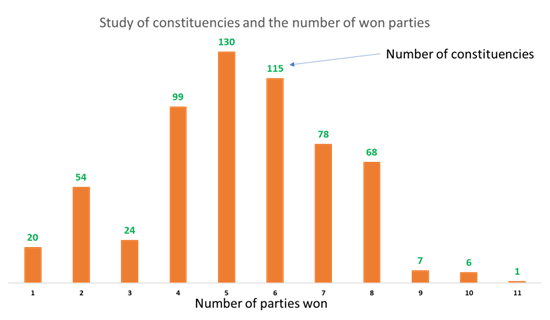The first set of questions for anyone wanting to know about a constituency is – Which party does he/she belong to? I tried to dig more into these questions. I retrieved all the constituencies and identified/counted the parties elected so far for each of the constituency. Apart from basic questions, this analysis sets the path to answer further interesting and compelling questions such as:
1. Which constituencies have predictable outcomes?
2. Which constituencies can swing for any party?
3. What will be a good estimate of victories for each party?
Planning for elections for a party begins by estimating the number of potential victories. This plot below gives an overview to this estimation. If a constituency has elected only one party all along over all the elections held so far, it is then a safe constituency for the party and it can count on it. On the other end, if a constituency has elected many different parties over the elections, then the party has to plan on devising strategies to win in that constituency. With tough and close elections, it becomes crucial for parties to know about their safe and swing constituencies.

This plot has the number of winning parties in the horizontal axis. The constituencies have been binned or grouped to each of these numbers. Looking at first bar says that there are 20 constituencies where only 1 party has been victorious in all the elections held so far. The second bar says that there are 54 constituencies where 2 parties have won so far and so on. The last two bars say there are 6 constituencies where 10 parties have won in different election years and 1 constituency where 11 parties have won in different election years. There have been 17 Lok Sabha elections so far from years 1951 to 2019.
This plot brings up a few noteworthy insights:
1. Of obvious and immediate interest are those constituencies which fall in the extremes – those which have had only one or two winning parties and those which have had 10 or 11 winning parties
2. Majority of the constituencies have elected between 4 and 8 parties so far
3. Adding up all the constituencies numbers comes to 602. But there are only 543 Lok Sabha constituencies. This is because some of the constituencies have ceased to exist or merged with other constituencies after 2004 report on study of delimitation studies on constituencies.
Of further interest will be to identify and study more about those constituencies which fall at extremes in the above plot. Another study that can be done in depth is the impact of delimitation of constituencies on election outcomes.
This blog has been moved from: bloghttps://coolovalanalysis.wordpress.com/2023/05/10/binning-constituencies-based-on-their-elected-parties/ger









Leave a Reply